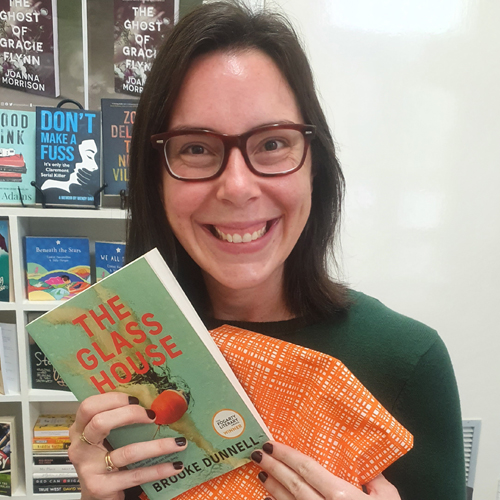Fogarty winner Brooke Dunnell says point of view, character and story are all irrevocably linked in her debut novel The Glass House

One of my favourite features of novels – and one that makes the art form different to many others – is their ability to take on the perspectives, words and thoughts of a fictional character. As readers, we feel the intimacy of being told a story and enjoy the benign voyeurism of having a window into others’ lives.
There are three different ways of communicating what can be seen through that window, generally referred to as point of view (POV): First person, where the storyteller is also one of the characters and uses the pronouns ‘I’ and ‘me’; second person, where the narrator addresses ‘you’, the reader, as a character in the story; and third person, where neither the narrator nor reader are part of the story in a bodily way.
Of course, using the third person doesn’t distance us from the characters completely. The privilege of fiction is that we can get into their heads in other ways.
When reading novels, we can only know what the characters and/or narrator know or suggest. Of course, as in real life, we also guess, make assumptions or come up with our own meanings from evidence presented (or nothing much at all). But when it comes to the nuts and bolts of the story, the storyteller has the ultimate power.
Readers aren’t puppets, though. They don’t want to feel tricked and they’ll get suspicious of vital information being held back for what seems to be no good reason. If a character knows something important, and it’s possible to share this knowledge, there needs to be an acceptable explanation for withholding until the end. Highly suspenseful genres like crime and mystery often follow an investigator or victim who doesn’t know the full story, offering an obvious explanation for why it takes most of the novel for ‘the big reveal’ to occur.
In my novel, The Glass House, the protagonist Julia Lambett returns to Perth to help her ninety-two-year-old father Don pack up the family home and transition into aged care. While there, she bumps into a childhood friend, Davina, who’s keen to resume their connection. Now in her mid-thirties, Julia doesn’t remember why she and Davina stopped being friends, and assumed their mothers were still close up until the early death of Julia’s mum, Goldie. The situation leads to much of the tension at the core of the novel.
Julia’s parents know what caused the end of the little girls’ friendship, so if Don’s thoughts and memories could be shared with readers, it would feel bizarrely restrictive to hold this information back. Similarly, having Davina’s perspective would mean giving her version of what went on twenty-five years ago. To allow for intrigue, I needed Julia, and therefore readers, to stay in the dark. So the choice to feature only one character’s thoughts, feelings and experiences – Julia’s – was woven into the novel’s premise. From here, I could choose to take on Julia’s first-person voice or use the third-person limited point of view.
I did try using the first person POV in an earlier version of the manuscript. Julia’s an enigmatic character, even to me; she doesn’t know herself well and she lives her life in service of other people’s needs. I hoped that accessing her voice directly would help to bring her alive, for readers and for me.
The exercise made me feel I understood her better, and part of this was realising that Julia would never tell her own story. She’s immensely private, as is her immediate family. Only when tipsy or under real duress does she start revealing personal things to Davina. I couldn’t have her under the influence for the whole novel, so the third person point of view became the obvious choice.
So we only get to know what Julia knows, and Julia doesn’t know what happened all those years ago. In order to find out, couldn’t she do something crazy like ask questions and listen to the answers?
Well, if Julia had an open and honest relationship with her father, maybe she would. But if we’re trying to make our fictional characters resemble real-life people, then they’re going to come with the complexities of real-life personalities and relationships. Don and Julia relate to one another in a slightly distanced, ‘everything-is-fine-don’t-ask’ kind of way. It’s not only the past that they avoid talking about – Julia isn’t confiding in her father about her marriage problems, and Don isn’t completely honest about living alone.
Having indirect and evasive conversations with people is one of those things that I find frustrating in reality but fascinating when depicted in fiction. Maybe this is because the fictional version is meant to have a purpose (even if it’s just to represent the truth), while the real-life equivalent feels so purposeless. In The Glass House, Julia and her father’s communication issues exist because they fit the characters, and they help to raise the tension and push the plot forward.
Julia has stifled dialogue with her father, has agreed not to speak to her husband and has few, if any, close friendships. She can’t even open up to readers. Her character has come about because of her upbringing and experiences, and because of this she can’t talk about her upbringing and experiences. She, Don and Davina all have to be pushed to the limit before the truth starts to be told.
In this way, point of view, character and story are all irrevocably linked. Tinkering with one will have ripple effects on the others; tweaking the others will echo back in the work. Like so many other aspects of novels, it’s all a balancing act.
But that’s part of the joy of writing. If we can find this balance, it feels effortless. The complications and difficulties along the way help us improve, and in the end, the story feels like it couldn’t have been told any other way.



